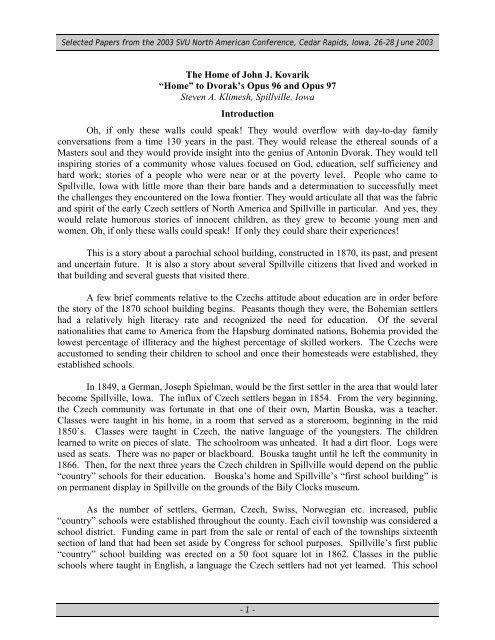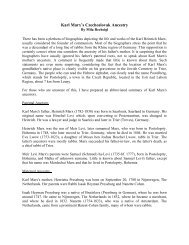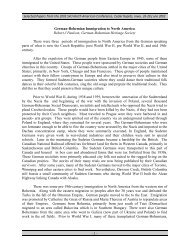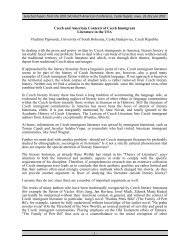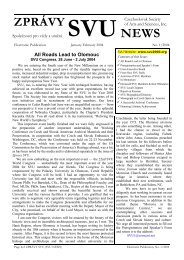Oh, if only these walls could speak - Czechoslovak Society of Arts ...
Oh, if only these walls could speak - Czechoslovak Society of Arts ...
Oh, if only these walls could speak - Czechoslovak Society of Arts ...
You also want an ePaper? Increase the reach of your titles
YUMPU automatically turns print PDFs into web optimized ePapers that Google loves.
Selected Papers from the 2003 SVU North American Conference, Cedar Rapids, Iowa, 26-28 June 2003<br />
The Home <strong>of</strong> John J. Kovarik<br />
“Home” to Dvorak’s Opus 96 and Opus 97<br />
Steven A. Klimesh, Spillville, Iowa<br />
Introduction<br />
<strong>Oh</strong>, <strong>if</strong> <strong>only</strong> <strong>these</strong> <strong>walls</strong> <strong>could</strong> <strong>speak</strong>! They would overflow with day-to-day family<br />
conversations from a time 130 years in the past. They would release the ethereal sounds <strong>of</strong> a<br />
Masters soul and they would provide insight into the genius <strong>of</strong> Antonin Dvorak. They would tell<br />
inspiring stories <strong>of</strong> a community whose values focused on God, education, self sufficiency and<br />
hard work; stories <strong>of</strong> a people who were near or at the poverty level. People who came to<br />
Spillville, Iowa with little more than their bare hands and a determination to successfully meet<br />
the challenges they encountered on the Iowa frontier. They would articulate all that was the fabric<br />
and spirit <strong>of</strong> the early Czech settlers <strong>of</strong> North America and Spillville in particular. And yes, they<br />
would relate humorous stories <strong>of</strong> innocent children, as they grew to become young men and<br />
women. <strong>Oh</strong>, <strong>if</strong> <strong>only</strong> <strong>these</strong> <strong>walls</strong> <strong>could</strong> <strong>speak</strong>! If <strong>only</strong> they <strong>could</strong> share their experiences!<br />
This is a story about a parochial school building, constructed in 1870, its past, and present<br />
and uncertain future. It is also a story about several Spillville citizens that lived and worked in<br />
that building and several guests that visited there.<br />
A few brief comments relative to the Czechs attitude about education are in order before<br />
the story <strong>of</strong> the 1870 school building begins. Peasants though they were, the Bohemian settlers<br />
had a relatively high literacy rate and recognized the need for education. Of the several<br />
nationalities that came to America from the Hapsburg dominated nations, Bohemia provided the<br />
lowest percentage <strong>of</strong> illiteracy and the highest percentage <strong>of</strong> skilled workers. The Czechs were<br />
accustomed to sending their children to school and once their homesteads were established, they<br />
established schools.<br />
In 1849, a German, Joseph Spielman, would be the first settler in the area that would later<br />
become Spillville, Iowa. The influx <strong>of</strong> Czech settlers began in 1854. From the very beginning,<br />
the Czech community was fortunate in that one <strong>of</strong> their own, Martin Bouska, was a teacher.<br />
Classes were taught in his home, in a room that served as a storeroom, beginning in the mid<br />
1850’s. Classes were taught in Czech, the native language <strong>of</strong> the youngsters. The children<br />
learned to write on pieces <strong>of</strong> slate. The schoolroom was unheated. It had a dirt floor. Logs were<br />
used as seats. There was no paper or blackboard. Bouska taught until he left the community in<br />
1866. Then, for the next three years the Czech children in Spillville would depend on the public<br />
“country” schools for their education. Bouska’s home and Spillville’s “first school building” is<br />
on permanent display in Spillville on the grounds <strong>of</strong> the Bily Clocks museum.<br />
As the number <strong>of</strong> settlers, German, Czech, Swiss, Norwegian etc. increased, public<br />
“country” schools were established throughout the county. Each civil township was considered a<br />
school district. Funding came in part from the sale or rental <strong>of</strong> each <strong>of</strong> the townships sixteenth<br />
section <strong>of</strong> land that had been set aside by Congress for school purposes. Spillville’s first public<br />
“country” school building was erected on a 50 foot square lot in 1862. Classes in the public<br />
schools where taught in English, a language the Czech settlers had not yet learned. This school<br />
- 1 -
Selected Papers from the 2003 SVU North American Conference, Cedar Rapids, Iowa, 26-28 June 2003<br />
remained in service for about 12 years. It was replaced by a larger facility in 1873. This school<br />
was then enlarged in 1885. A new public school was erected in 1903.<br />
In 1870, the parishioners <strong>of</strong> St. Wenceslaus parish constructed the community’s first<br />
parochial school, the underlying subject <strong>of</strong> this paper. This building would be constructed on<br />
part <strong>of</strong> the ten acres <strong>of</strong> land deeded to the parish by Roman Expelier and his w<strong>if</strong>e in December <strong>of</strong><br />
1859. The parishioners would construct two more parochial schools on this land, one in 1900,<br />
which would be razed in 1954, and one in 1953. And so the story <strong>of</strong> the 1870 parochial school<br />
building can now begin.<br />
1868 to 1893 – John Joseph (J. J.) Kovarik<br />
As previously stated, upon the departure <strong>of</strong> Martin Bouska in 1866, Spillville’s Bohemian<br />
<strong>speak</strong>ing children relied on the public schools for their education. In April 1868 a more<br />
“satisfactory” education process for the Czech Catholic citizens and children <strong>of</strong> Spillville would<br />
present itself when an 18 year old John J. Kovarik completed his voyage from Vsetec, Bohemia<br />
with his arrival in Spillville. He would immediately become involved in St. Wenceslaus parish<br />
l<strong>if</strong>e, becoming the church organist and the teacher in the parish school. He would serve as the<br />
parish teacher for nearly a quarter <strong>of</strong> a century.<br />
J. J. Kovarik settled with his parents on a farm about two miles west <strong>of</strong> Spillville. Since<br />
the parish had no school building in 1868, classes were originally held in the parish rectory.<br />
Space limitations were a problem there, and so during the winter <strong>of</strong> 1869 – 1870, Kovarik taught<br />
the children in a room above a saloon owned by Thomas Dvorak.<br />
In 1870, John married Elizabeth Riha. It was also in 1870 that a substantial parochial<br />
school building was constructed. There was one large classroom on the ground floor, and the<br />
remainder <strong>of</strong> the building was used as living quarters for the Kovariks. The Kovarik’s would<br />
have seven children; six would reach adulthood. The first born, Joseph John Kovarik, born in<br />
1871, would in later years be instrumental in bringing Antonin Dvorak to Spillville.<br />
As a teacher, Mr. Kovarik had the distinct advantage over his contemporaries in the<br />
township schools <strong>of</strong> being able to instruct in all three <strong>of</strong> the languages spoken by his pupils;<br />
Czech, German and English. In a letter dated December 3, 1971, J. J.’s daughter, Anna Mary<br />
Kovarik, wrote:<br />
“In his records dad states that the average number <strong>of</strong> pupils in the school was 60<br />
and during the winter season (added – when the children were not needed on the<br />
farm for planting or harvest) the number increased to 110. With this in mind, and<br />
knowing that the ages <strong>of</strong> the children varied from 6 to 12 or older and that the<br />
teaching had to be done in three languages, the English, Bohemian and German,<br />
one realizes what an enormous task this was.”<br />
- 2 -
Selected Papers from the 2003 SVU North American Conference, Cedar Rapids, Iowa, 26-28 June 2003<br />
The curriculum was restricted to the basics, but the children were not short changed.<br />
Kovarik worked hard to give his pupils more than a cursory education and his list <strong>of</strong> exceptional<br />
students who would go on to prominent positions is a long one. Notable are:<br />
• The Very Reverend Prokopius Neuzil: He became a teacher, then a priest and at age 26<br />
founded St. Prokopius College in Lisle, Illinois. He later helped to establish the<br />
Benedictine Abbey Press. He also served as Abbot <strong>of</strong> the Abbey.<br />
• Dr. Alois F. Kovarik: He continued his education, earning a doctorate in physics at the<br />
University <strong>of</strong> Minnesota and later became a Pr<strong>of</strong>essor <strong>of</strong> Nuclear Physics at Yale<br />
University. During World War I, he was a member <strong>of</strong> an important federal government<br />
panel studying counter-measures against German submarines. Dr. Kovarik also<br />
participated on the Manhattan Project during World War II. The sign<strong>if</strong>icant product <strong>of</strong><br />
this effort was the atomic bomb.<br />
• James S. Mikesh became an author and theologian who taught at Yale and at Harvard.<br />
In 1893 J.J. Kovarik gave up his teaching post to devote more time to his music. He<br />
moved to New Prague, Minnesota in 1899 where he continued his music career as a music<br />
teacher, orchestra leader and choirmaster. John J. Kovarik died in 1939 at age 89 in New Prague,<br />
MN. In a New Prague newspaper article written by Frances Boardman and published shortly<br />
after Kovarik’s death, Boardman stated that Kovarik “… left behind him the deathless results <strong>of</strong><br />
an influence immeasurably good and honest and wise and kind. Among his children and<br />
grandchildren and other relatives are names that figure importantly in the American world <strong>of</strong><br />
music and science.”<br />
1871 to 1894 – Joseph John Kovarik<br />
One very notable pupil <strong>of</strong> John J. Kovarik was his son Joseph. John’s true love was<br />
music, in which he instructed his family thoroughly. With a solid foundation in music learned<br />
from his father, at age 13, Joseph went on to attend music school in Milwaukee, Wisconsin. At<br />
age 18 Joseph began his studies at the Prague Conservatory <strong>of</strong> Music in Prague, Bohemia.<br />
Joseph was a member <strong>of</strong> the New York Philharmonic Orchestra for 41 years. He was also a<br />
violin and viola instructor at the National Conservatory <strong>of</strong> Music in New York City and at the<br />
New York College <strong>of</strong> Music in New York City. The Russian conductor Vasili Safanov declared<br />
that Joseph Kovarik was the best violist he had ever heard.<br />
Without question, one <strong>of</strong> the most important facets <strong>of</strong> Joseph’s l<strong>if</strong>e had to be his<br />
relationship with Antonin Dvorak. It was while he was at the Conservatory in Prague that he met<br />
and became a close friend and companion <strong>of</strong> Dvorak, the famous Czech composer. The<br />
momentous event took place one day in 1892 while Kovarik was reading an American paper in a<br />
Prague music store. Dvorak entered the store, and, seeing that Kovarik was reading an American<br />
paper, asked <strong>if</strong> he were American. Upon learning that he was, Dvorak asked <strong>if</strong> Kovarik would<br />
consider accompanying him to America where he was to take charge <strong>of</strong> the New York<br />
Conservatory <strong>of</strong> Music. Kovarik agreed and later became Dvorak’s close friend, traveling<br />
companion and personal secretary in America.<br />
- 3 -
Selected Papers from the 2003 SVU North American Conference, Cedar Rapids, Iowa, 26-28 June 2003<br />
Dvorak, traveling with several family members and Joseph Kovarik, arrived in New York<br />
on September 28, 1892: St. Wenceslaus Day. During the next several months Dvorak, a “country<br />
gentleman”, became homesick. He was planning to spend his four-month-long vacation at his<br />
country home in Vysoka, Bohemia, but, fascinated by Kovarik’s vivid descriptions <strong>of</strong> Spillville,<br />
Iowa and its people, the composer changed his mind and made arrangements to spend the<br />
summer <strong>of</strong> 1893 in Spillville. This pleased Kovarik since he had not seen his family in five<br />
years.<br />
In his book THEY CAME TO THIS PLACE, Cyril Klimesh writes that Dvorak arrived in<br />
Spillville on June 5 , 1893 and<br />
“On his first morning in Spillville, Dvorak was up at dawn, roaming and<br />
exploring the paths around the village. A little later, when Kovarik’s mother…<br />
caught sight <strong>of</strong> the Master at 5 o’clock in the morning, walking up and down in<br />
front <strong>of</strong> the school, she got a great fright as she thought something unpleasant<br />
must have happened whereon the Master replied: ‘Nothing happened – and yet a<br />
great deal. Imagine, I was walking there in the woods along by the stream and<br />
after eight months I heard again the singing <strong>of</strong> birds! And here the birds are<br />
d<strong>if</strong>ferent from ours, they have much brighter colors and they sing d<strong>if</strong>ferently too.<br />
And now I am going to breakfast and after breakfast I shall come again.’”<br />
The above suggests that Antonin Dvorak did not live in the home <strong>of</strong> J. J. Kovarik. Some old time<br />
Spillville citizens however maintain that he did spend the first few nights with the Kovariks after<br />
his arrival in Spillville.<br />
What is certain, however, is that Antonin Dvorak spent many hours in the Kovarik home.<br />
It is also certain that Dvorak composed two sign<strong>if</strong>icant works while in Spillville: Opus 96:<br />
“Quartet in F Major” (affectionately named the “Spillville Quartet” by Dvorak himself), begun<br />
and completed in June <strong>of</strong> 1893, and Opus 97: “Quintet in E Flat Major”, a work that reflects<br />
Indian melodies, completed on August 1 st 1893. It is also certain that the first presentations <strong>of</strong><br />
Opus 96 and Opus 97 were in the Kovarik home, the 1870 parochial school building. The<br />
musicians for <strong>these</strong> first “concerts” included several members <strong>of</strong> the Kovarik family, and Dvorak<br />
himself. The most probable location <strong>of</strong> the performance would be the school room since this<br />
room would have served as a social center for the community and is where J. J. would have<br />
conducted band practice, choir practice and periodic sing fests.<br />
Concerning Opus 96 and Opus 97 Cyril Klimesh, in his book THEY CAME TO THIS<br />
PLACE, states:<br />
“As soon as <strong>these</strong> compositions were completed, Dvorak asked the Kovarik family<br />
to join him in playing them. Joseph Kovarik wrote: ‘The whole family was<br />
mobilized for it. Dvorak played the first violin, my father the second, my sister<br />
the viola and I the cello. We went at it full steam. It wasn’t easy, but we finally<br />
succeeded. And for the string quintet, my brother (John) came from Chicago.<br />
- 4 -
Selected Papers from the 2003 SVU North American Conference, Cedar Rapids, Iowa, 26-28 June 2003<br />
We felt it to be glorious to play Dvorak’s chamber pieces, and he himself was able<br />
to hear them immediately after composing them. The whole family was delighted,<br />
even <strong>if</strong> it was a drudgery. Our house echoes with Dvorak’s music.’”<br />
The effects Spillville and its environs had on Dvorak are <strong>of</strong>ten and well documented.<br />
Who can say how the events <strong>of</strong> music history might have unfolded had Joseph not met Antonin<br />
Dvorak and brought him to Spillville.<br />
Joseph Kovarik died in 1951.<br />
1893 to 1976 – Other Notable Teachers and the Teaching Nuns<br />
In 1893, Father Thomas Bily obtained the services <strong>of</strong> the Sisters <strong>of</strong> St. Benedict <strong>of</strong> Lisle,<br />
Illinois. The Sisters would instruct the parochial school children until 1898. For the next two<br />
years the students would be taught by three layman; Dr. W. Ivory, Francis Tinker and Hynek<br />
Dostal. Little is known about Dr. W. Ivory or Francis Tinker, who also served as Spillville’s<br />
dentist.<br />
However, a great deal is known about Dr. Dostal. Hynek Dostal was born on December<br />
29, 1871, in Borsice, Moravia. After receiving his elementary education in his hometown, he<br />
attended college at Uherske Hradiste in 1884. He continued his education at institutions in<br />
Prerov, Olomouc and Nemecky Brod. After a short period <strong>of</strong> army service, he resumed his<br />
studies at the academy in Pribram and later graduated from law school at the University <strong>of</strong><br />
Prague. Dr. Dostal received his doctorate in letters from the University <strong>of</strong> Tiberia.<br />
Hynek intended to take a position in Vienna when he received a telegram from his brother<br />
Joseph. The telegram urgently requested him to come to America and teach at the Czech<br />
parochial school in Spillville, Iowa. So Hynek, like many <strong>of</strong> his countrymen, left his homeland<br />
for a new l<strong>if</strong>e in America. Then, in 1900, Archbishop Keane <strong>of</strong> Dubuque issued an order stating<br />
that nuns must teach all parochial schools. Forced out <strong>of</strong> his job, Hynek moved to Chicago where<br />
he was associate editor <strong>of</strong> the daily paper, Narod.<br />
The full l<strong>if</strong>e story <strong>of</strong> Dr. Hynek Dostal is an incredible one and much about this famous<br />
Czech patriot and immigrant can be found on the World Wide Web at<br />
http://homepage.mac.com/williamszone/dostal/dostal.html. Among the notable aspects and<br />
achievements <strong>of</strong> his l<strong>if</strong>e after teaching in Spillville were:<br />
• In 1901, Msgr. Hessoun <strong>of</strong>fered Hynek Dostal the position <strong>of</strong> editor <strong>of</strong> "HLAS". HLAS<br />
was the first Czech-Catholic newspaper in America. HLAS was founded in 1873 by<br />
Msgr. Josef Hessoun <strong>of</strong> the St. John Nepomuk parish in St. Louis. The word HLAS<br />
means "voice” and the paper served as a voice to unite the Bohemian-American people<br />
under the banner <strong>of</strong> Catholicism. His appointment as editor would encompass the rest <strong>of</strong><br />
his l<strong>if</strong>e and provide a means to help liberate his homeland. Dr. Dostal, along with his<br />
w<strong>if</strong>e, created another periodical, Ceska Zena, which translates to "Bohemian Lady."<br />
- 5 -
Selected Papers from the 2003 SVU North American Conference, Cedar Rapids, Iowa, 26-28 June 2003<br />
• On May 31, 1918 The Pittsburgh Agreement was signed. In the agreement, the American<br />
Czechs and Slovaks for the first time in a public, written paper, pledged support for a<br />
common country. At the same time, the agreement affirmed the independent nature <strong>of</strong> the<br />
two republics. Thomas Masaryk's signature on the document made it an <strong>of</strong>ficial<br />
declaration <strong>of</strong> the <strong>Czechoslovak</strong> National Council. Directly below and to the right <strong>of</strong><br />
Masaryk's signature is that <strong>of</strong> Hynek Dostal. The signatures confirm that Thomas<br />
Masaryk and Hynek Dostal had a pr<strong>of</strong>essional relationship, <strong>if</strong> not a personal one<br />
In 1929, the St. Louis Globe-Democrat reported on the meetings between Dostal and<br />
Masaryk that took place at the "HLAS" print shop in St. Louis ten years earlier “"Dr.<br />
Hynek Dostal was associated with Dr. Thomas G. Masaryk in the work <strong>of</strong> liberating the<br />
Czechs and the Slovakians from Austrian rule and in 1919-1920 was largely instrumental<br />
in the creation <strong>of</strong> the present Republic <strong>of</strong> <strong>Czechoslovak</strong>ia. He worked for that cause in<br />
both America and Europe. Dr. Masaryk, now president <strong>of</strong> the new republic, twice visited<br />
St. Louis to confer with Dr. Dostal; so it may be said that, in a sense, the map <strong>of</strong> Europe<br />
was changed by zealous liberators who met in a small room on South Eleventh Street in<br />
St. Louis, near the center <strong>of</strong> the Bohemian settlement.<br />
• In June 1928, Dr. Dostal received not<strong>if</strong>ication from Pope Pius XI that he had been made a<br />
Knight <strong>of</strong> the Order <strong>of</strong> St. Gregory the Great. The Order <strong>of</strong> the Knighthood <strong>of</strong> St. Gregory<br />
the Great was instituted by Pope Gregory XVI on September 1, 1831. It is the highest<br />
honor that a layman in the Catholic Church can attain. It represents recognition by the<br />
Holy Father <strong>of</strong> special virtue and unusual labors for the Church <strong>of</strong> God and country. A St.<br />
Louis Globe Democrat Article dated September 18, 1934, announced the Knight <strong>of</strong> St.<br />
George award being presented to Hynek. During his l<strong>if</strong>etime Hynek Dostal received many<br />
awards including the Knight <strong>of</strong> St. Gregory, Knight <strong>of</strong> St. George, Commander <strong>of</strong> Fort St.<br />
Rufina, Doctorate in letters from the University <strong>of</strong> Tiberia, the Pro Pont<strong>if</strong>ice et Ecclesia<br />
and Pro Fide et Ecclesia medals.<br />
• On September 23, 1937, President Franklin Roosevelt signed a proclamation that made<br />
Hynek Dostal <strong>Czechoslovak</strong>ian consul in St. Louis<br />
In 1900, a four-room brick school building was erected and dedicated. The 1870 school or<br />
“Old School” was remodeled and became a residence for the teaching Sisters. The Sisters <strong>of</strong> St.<br />
Francis <strong>of</strong> Milwaukee, Wisconsin replaced the Benedictine Sisters and taught until 1914. It was<br />
in 1914 that the teaching responsibilities were taken over by the School Sisters <strong>of</strong> Notre Dame <strong>of</strong><br />
Fenton, Missouri. The Orders Motherhouse was in Horazdovice, Bohemia. The School Sisters<br />
later moved their headquarters to Omaha, Nebraska. The Notre Dame’s would teach the youth <strong>of</strong><br />
St. Wenceslaus parish for the next 62 years, or until 1976.<br />
The early schools lacked many <strong>of</strong> the fine points enjoyed by today’s institutions. In spite<br />
<strong>of</strong> uncomfortably furnished buildings, the lack <strong>of</strong> teaching materials and an inadequate supply <strong>of</strong><br />
books, the teachers, through discipline and a devotion to their work, managed to turn out young<br />
men and women well qual<strong>if</strong>ied to take their place in society.<br />
In 1954, a new grade school opened and the school built in 1900 was razed. Under the<br />
guidance <strong>of</strong> the Sisters <strong>of</strong> Notre Dame, the school flourished. Normal staffing by the Sisters<br />
- 6 -
Selected Papers from the 2003 SVU North American Conference, Cedar Rapids, Iowa, 26-28 June 2003<br />
consisted <strong>of</strong> four teaching nuns and one or two housekeepers. In 1960, there were 187 children<br />
enrolled. Then, in the mid sixties and into the seventies the number <strong>of</strong> pupils declined. The staff<br />
<strong>of</strong> teaching nuns was reduced as a result <strong>of</strong> the declining enrollment in the school, and, as a result<br />
<strong>of</strong> a declining number <strong>of</strong> teaching sisters due to declining vocations. Finally, in May <strong>of</strong> 1976, the<br />
Motherhouse <strong>of</strong> the Sisters <strong>of</strong> Notre Dame not<strong>if</strong>ied the parish that they <strong>could</strong> no longer staff the<br />
school. Teaching duties then fell to lay teachers.<br />
For short time periods after 1976, the “Old School” served as a home for some <strong>of</strong> the lay<br />
teachers and as a home for the parish custodian. For the most part, however, it served as a<br />
storage facility for the next 25 years.<br />
1917 to 1955 - The Boarders<br />
One <strong>of</strong> the most unique uses <strong>of</strong> the “Old School” was that <strong>of</strong> “boarding house”. This was<br />
made possible when, in 1917, a major renovation <strong>of</strong> the buildings interior took place. The<br />
building was reconfigured so that local farm children <strong>could</strong> be brought to school on Monday<br />
morning, learn their lessons, live in the “Old School” or “convent” as it was getting to be known,<br />
and return to the farm on Friday after classes. Boarding <strong>of</strong> the local children continued until<br />
1955.<br />
Imagine, <strong>if</strong> you will, as many as 30 boys and girls living together with 4 teaching nuns<br />
and 2 housekeeping nuns. What would it have been like? What values would the children have<br />
learned from this experience?<br />
The year was 1947 and Lester Humpal, a local Spillville resident and clever young farm<br />
lad who spoke <strong>only</strong> Czech, something not uncommon in the Spillville area as late as the mid<br />
1950’s, was “on the run”. He was following the winding curves <strong>of</strong> the Turkey River. He was on<br />
the run from the square building topped with a cupola’s cross; on the run from the intimidating<br />
nuns who <strong>only</strong> spoke English in class; on the run from the convent where his family had left him.<br />
Lester thought he was home free, but a farmer caught him three miles from the school and<br />
took him home. His father dragged him back to the convent, where he spent eight school years<br />
during his young l<strong>if</strong>e.<br />
The time in the convent with the nuns, and other youngsters, although traumatic at times,<br />
provided a foundation that lasts a l<strong>if</strong>etime. Lester says he learned values. Values like discipline,<br />
responsibility and teamwork. Values he carries to this day. Lester is now 62 and working to save<br />
the “Old School.”<br />
Lester understands the boarders formed a second family, a home away from home. They<br />
worked together, and the oldest ones helped the littlest ones with their chores. The youngsters<br />
also took full advantage <strong>of</strong> the 90 minutes <strong>of</strong> free time allotted the children each day after school.<br />
They would don their “roughin’ clothes” to play s<strong>of</strong>tball or tag. “There weren’t any cliques,<br />
everyone was equal.”<br />
- 7 -
Selected Papers from the 2003 SVU North American Conference, Cedar Rapids, Iowa, 26-28 June 2003<br />
Consider a “playground” with <strong>only</strong> your imagination for creating games and sport. How<br />
can you use an old water pump for amusement? What games <strong>of</strong> skill <strong>could</strong> be devised?<br />
According to one boarder, Joe Spalla, the challenge was to see how many times an individual<br />
<strong>could</strong> pump the handle without getting stung by the resident wasps. The record for pumps is held<br />
by Joe - 6. However, it is a tainted record, since he sustained 10 stings in the process. On the<br />
positive side, the day Joe set this “record” he received the <strong>only</strong> steak he ever got during the 8<br />
years he boarded at the “convent”; unfortunately the steak was not cooked or ready for eating; it<br />
was raw and applied to the stings.<br />
The 1870 “Old School<br />
The school stands on 10 acres <strong>of</strong> land deeded to the parish in December 1859 by Roman<br />
Eggspuehler (a Swiss immigrant) and his w<strong>if</strong>e Magdalene. Magdalene was the daughter <strong>of</strong><br />
Spillville’s founder Joseph Spielman.<br />
There are several facts about the 1870 building worthy <strong>of</strong> note. They include:<br />
• Research recently completed by myself validates that the St. Wenceslaus “Old School”, or<br />
the home <strong>of</strong> J.J. Kovarik, and, “Home” to Dvorak’s Opus 96 and Opus 97, is the oldest<br />
standing Czech Catholic School in the United States. It is also worthy to note that this<br />
same research has determined that the St. Wenceslaus Church is the oldest standing Czech<br />
Catholic Church in the United States.<br />
• The Old School is an excellent example <strong>of</strong> vernacular (native to the country) masonry<br />
construction.<br />
• The foundation <strong>of</strong> the building is native limestone.<br />
• The <strong>walls</strong>, fully 20 plus inches thick, are two parallel native limestone <strong>walls</strong> with “rubble”<br />
fill in between. Construction <strong>of</strong> this type was an insulation technique.<br />
• A mystery remains as to whether or not there were two front entry doors on the school at<br />
one point in time; a north entrance and a south entry; one for the boys and one for the<br />
girls. All known photos show the current one door facing east configuration. However,<br />
recent bell tower foundation stabilization work revealed strong evidence that at least, a<br />
south facing door was in place at one point in time.<br />
The Future <strong>of</strong> the 1870 “Old School” Building<br />
The future <strong>of</strong> the “Old School”, the “convent”, the J. J. Kovarik home, or the “Home” to<br />
Dvorak’s Opus 96 and Opus 97 is in doubt as <strong>of</strong> June 2003. The Saint Wenceslaus parish has<br />
little use for the structure. In 2001, the parish council recommended the building be razed. At<br />
that time, a small group <strong>of</strong> individuals formed the Saint Wenceslaus Heritage <strong>Society</strong>. The<br />
Mission Statement <strong>of</strong> that group is in part to “…seek to retain, restore, and maintain the religious,<br />
architectural, historical and ethnic integrity <strong>of</strong> the St. Wenceslaus Church and its properties”.<br />
While incredibly structurally sound after 130 years, there was some recent deterioration <strong>of</strong><br />
the foundation and <strong>walls</strong> associated with the bell tower. The Heritage <strong>Society</strong> was successful in<br />
- 8 -
Selected Papers from the 2003 SVU North American Conference, Cedar Rapids, Iowa, 26-28 June 2003<br />
correcting <strong>these</strong> problems in 2002 with a project “partially supported with funding from the<br />
Resource and Protection (REAP) Act through a Historical Resource Development Program<br />
(HRDP) grant from the State Historical <strong>Society</strong> <strong>of</strong> Iowa”. The building is again, structurally<br />
sound.<br />
The major task facing the Heritage <strong>Society</strong> for 2003 is the installation <strong>of</strong> a new metal<br />
ro<strong>of</strong>, similar to one that was in place from the 1880’s through 1915, and installation <strong>of</strong> new<br />
gutters and downspouts.<br />
The Heritage <strong>Society</strong> is also working to have the St. Wenceslaus properties, the church,<br />
the rectory, the adjacent cemetery and the “Old School” or home <strong>of</strong> J. J. Kovarik and “Home” to<br />
Opus 96 and 97 designated as a Historic District on the National Register <strong>of</strong> Historic Places. In<br />
December 2002, the Heritage <strong>Society</strong> made application for a Cert<strong>if</strong>ied Local government (CLG)<br />
grant, to be used for completing the required applications and forms for nominating and placing<br />
the St. Wenceslaus facilities on the National Register <strong>of</strong> Historic places. This effort was<br />
sponsored by the Winneshiek County Historic Preservation Commissioners and endorsed by the<br />
Winneshiek County Board <strong>of</strong> Supervisors. The application was denied in January 2003.<br />
However, not to be deterred, the Heritage <strong>Society</strong> continues to work to have the properties<br />
designated as a Historic District. And, to that end, the Heritage <strong>Society</strong> and The Winneshiek<br />
County Historic Preservation Commissioners have assembled a group <strong>of</strong> dedicated individuals,<br />
companies and organizations that will be pursuing the effort and providing a great deal <strong>of</strong> work<br />
on a pro bono basis.<br />
In the “History <strong>of</strong> Czechs in America” Jan Habenicht wrote:<br />
“The whole extended countryside with the little towns <strong>of</strong> Spillville,<br />
Protivin, Lourdes, Fort Atkinson, and Little Turkey, the railroad station at Jackson<br />
Junction and other communities is inhabited by Czechs.”<br />
“This territory, so thick with Czechs, has its own special character. Thanks<br />
to their thr<strong>if</strong>t and persistence, <strong>these</strong> Czechs reached much influence….”<br />
“We can learn from this what it takes to save our Czech heritage here in<br />
America. The Czech school, Czech church, national self-confidence and<br />
economical influence, determined by persistence and thr<strong>if</strong>t.”<br />
In Spillville, Iowa we are blessed with having the oldest, still standing Czech Catholic<br />
Church (1860) in the United States and the oldest, still standing Czech Parochial School (1870) in<br />
the United States. The “Old School” represents the very essence <strong>of</strong> our Czech culture and<br />
heritage. It also has an undeniable place in music history and the l<strong>if</strong>e <strong>of</strong> Antonin Dvorak. These<br />
facilities are priceless. We owe it to ourselves and to future generations to ensure <strong>these</strong> tangible<br />
signs <strong>of</strong> our forefathers’ drive, determination, accomplishments and values survive the 21 st<br />
century and beyond.<br />
- 9 -
Selected Papers from the 2003 SVU North American Conference, Cedar Rapids, Iowa, 26-28 June 2003<br />
I wish to recognize and thank Cousin Cyril M. Klimesh and the past and present<br />
parishioners <strong>of</strong> St. Wenceslaus parish for their assistance and input is developing and<br />
documenting the material presented in this paper.<br />
Steven A. Klimesh<br />
Box 127<br />
105 Pleasant View Drive<br />
Spillville, Iowa 52168<br />
- 10 -


